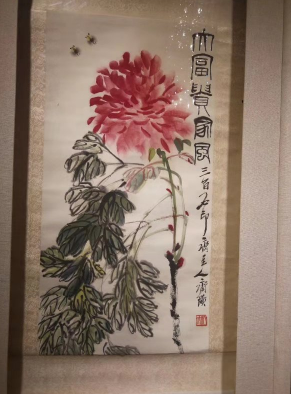時(shí)常聽到朋友評(píng)論某位書畫家的作品時(shí)說(shuō):“他的畫真好,你看畫的多像呀!”一幅好的書畫作品,不能單憑像和不像來(lái)論好壞,而要看是否星神兼?zhèn)洹I綎|收購(gòu)名人字畫提示我們,要追求神的格調(diào),走出形的誤區(qū)。
Often I hear a friend comment on a painter's work and say, "His paintings are very good. You can see how much they look like!" A good painting and calligraphy can not be judged by image and unlikeness alone, but by the combination of stars and gods. Shandong's acquisition of celebrity paintings and calligraphy reminds us that we should pursue the style of God and get out of the misunderstanding of shape.
繪畫藝術(shù)有形似、神似之分,形似是神似的基礎(chǔ),神似是形似的提高。古代畫家就認(rèn)識(shí)到不能顧了形似,忘了神似,而應(yīng)力求神似。為什么有的作品看起來(lái)呆板、僵化、不生動(dòng),有的作品卻栩栩如生、呼之欲出、生動(dòng)自然?關(guān)鍵就在于前者“貌合神離”,后者“星神兼?zhèn)?rdquo;。因此,一幅書畫作品不能只看它像不像,關(guān)鍵是要看它是否具有神韻。
Chinese painting art can be divided into physical similarity and spiritual similarity, which is the basis of Spiritual Similarity and the improvement of spiritual similarity. Ancient painters realized that they could not ignore the likeness of form and forget the likeness of god, but should strive for the likeness of god. Why do some works seem rigid, rigid and lifeless, while others are vivid, vivid and natural? The key lies in the former's combination of appearance and divinity, and the latter's combination of stars and gods. Therefore, a painting and calligraphy can not only look like it or not, the key is to see whether it has charm.

鑒賞收藏書畫作品,看似簡(jiǎn)單,實(shí)際上大有講究,需要有豐富的文化修養(yǎng)。北宋文學(xué)家沈括曾經(jīng)感慨某些書畫收藏家只取空名,聽說(shuō)是名家之作,就搶著收購(gòu),他稱這種人為“耳鑒”;另一種人以為畫上顏色不會(huì)染上手指就是好畫,于是遇見畫就摸,他稱這種人又在“耳鑒之下”,稱之為“揣骨聽聲”。顯然這兩種方法都是不可取的。唐代畫家閻立本看南朝畫家張僧鷂的作品,剛開始他感覺到莫名其妙,說(shuō)“定虛得名耳”;再去看后又說(shuō)“猶是近代佳手”;當(dāng)他第三次再去看的時(shí)候,激動(dòng)地說(shuō):“名下無(wú)虛士!”因此我們?cè)谑詹孛嗣易之嬛校叫撵o氣,不能浮躁,也不能懷有成見,通過認(rèn)真細(xì)致的觀察、分析、領(lǐng)會(huì),才能不被一些表面現(xiàn)象所迷惑,才能買到真正具有收藏意義的貨真價(jià)實(shí)的名人字畫。
Appreciating and collecting paintings and calligraphy seems simple, but in fact, it is very exquisite and needs rich cultural accomplishment. Shen Kuo, a writer of the Northern Song Dynasty, once lamented that some collectors of calligraphy and paintings only took empty names and rushed to acquire them when they heard that they were masterpieces. He called them "ear gazetteers". Another thought that the color on the paintings could not be dyed by fingers was a good painting, so he touched the paintings when he met them. He called them "under ear gazetteers", and called them "bone-piercing and sound-piercing". Obviously, both methods are not advisable. Yan Liben, a painter of Tang Dynasty, looked at the works of Zhang Sengyuan, a painter of Southern Dynasty. At first, he felt puzzled and said, "Definitely deserve fame and ears". Then he went to see them and said, "He is still a master of modern times". When he went to see them for the third time, he said excitedly, "There are no empty men under the name!" Therefore, in collecting celebrity paintings and calligraphy, we should be calm, not impetuous, nor prejudiced. Only by careful observation, analysis and understanding, can we not be confused by some superficial phenomena, and can we buy genuine and genuine celebrity paintings with collective significance.
本文來(lái)自:山東收購(gòu)名人字畫,更多的內(nèi)容請(qǐng)點(diǎn)擊:
http://www.zhiyou999.com我們將會(huì)為您提問的問題提供一個(gè)滿意的服務(wù),歡迎您的來(lái)電!
This article is from: Shandong purchases celebrity calligraphy and painting, more content please click:
http://www.zhiyou999.com, we will provide you with a satisfactory service to ask questions, welcome your call!
